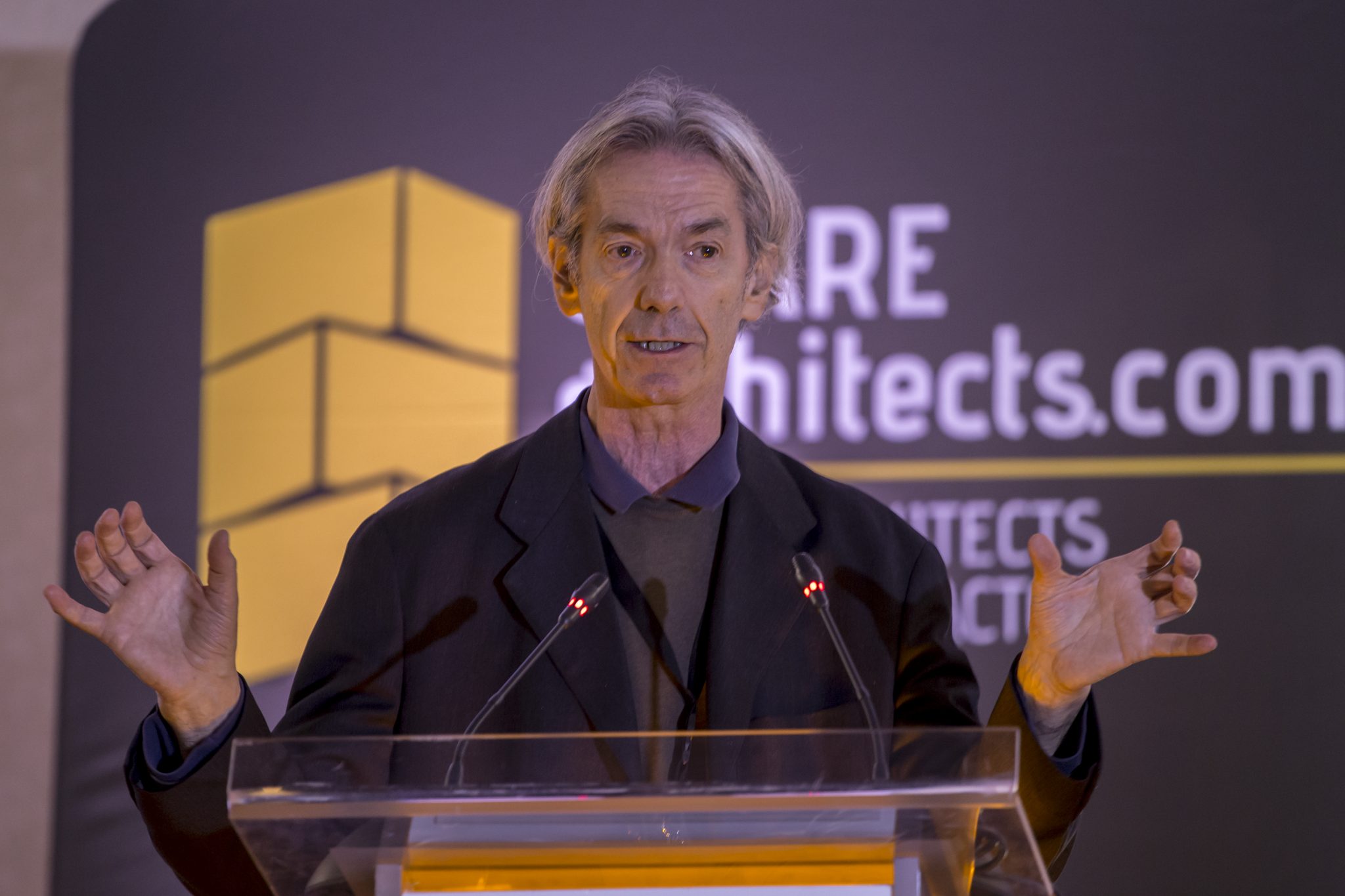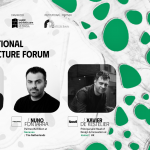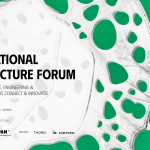Architecture, Today. A conversation with Renato Rizzi for share-architects.com
The Italian architect Renato Rizzi joined us during SHARE Forum Bucharest 2017, on 6-7 November, at the JW Marriott Grand Hotel. He was a guest speaker in the plenary session of the RIFF 2017 expo-conference where he presented his winning entry for the Shakespearean Theatre in Gdansk, Poland, built in 2014. Moreover, he was a member of the international jury for the second edition of the Romanian Building Awards competition 2017, attending the live presentations of the 16 finalists nominated by the Board.
Arch. Renato Rizzi will speak at the SHARE Budapest event on 25th October 2018 at the Budapest Music Center.
Renato Rizzi is a lecturer at the Instituto Universitario di Architettura in Venice where he has a strong professional activity always in between theory and practice. He worked for over 10 years with another well-known architect – Peter Eisenman – a period which influenced his unique and powerful approach to the profession.
In 1984 he wins the competition for the sports facility in Trento, completed in 2002, receiving in 1992 the First National Prize In/Arch. He worked for over 10 years with Peter Eisenman, a period which influenced his unique and powerful approach to his profession. From that period originate the projects of La Villette in Paris, the new headquarters of Monte dei Paschi in Siena, the plans of the Opera House in Tokyo and the Torre della Ricerca in Padova. He is present in many international architecture competitions in New Zealand, Warsaw, Berlin, Barcelona, Copenhagen, Krakow. In 2003 he receives the Italian Architecture Gold Medal and the third prize at the competition for the Grand Egyptian Museum in Cairo. In 2009 he is awarded the Gold Medal at the Milan Triennale and the European Council Landscape Prize for the project entitled Casa Museo Depero, built in 2008. His other professional achievements were only possible through intense research. Among his most important publications are Mistico nulla in 1996, Le voci dell’ozio in 1999, Il divino del paesaggio in 2008, Il Daimon di Architettura, Theoria-Eresia in 2006; La muraglia ebraica: l’impero eisenmaniano in 2009; John Hejduk: Incarnatio in 2010; L’Inconciliabile with R.Toffolo and M.Donà in 2010; L’Aquila-S(c)isma dell’Immagine in 2011 and Parma Inattesa in 2013.
In the past he held conferences in Harvard, Cairo, La Plata and Auckland. His work has been included in the Venice Architecture Biennial in 1984, 1985, 1996, 2002, 2010 and 2016. Since 2009 he has been the director of Estetica e Architettura, a column at the Mimesis Edizioni publishing house in Italy.
Renato Rizzi approaches research, architecture and teaching as a whole, trying to reestablish the ontological and metaphysical thought as intimately linked to the understanding of the contemporary condition of Architecture.
During the two days of the conference, Mr. Renato Rizzi was kind enough to offer us the following interview.
Ruxandra Grigoras: A new debate has just been launched during SHARE Forum 2017 Bucharest. It is related to the condition of the future architect and it desires to draw a profile of our profession in the future. My question would be instead: how would you define this condition today and what would be the main issues the architect faces nowadays?
Renato Rizzi: Usually people start speaking almost immediately about the problems with the client, the money, the number of square meters, the technical problems, lighting, heating, cars…But hey! This doesn’t mean anything if it is not rooted in the domain of the arche! There are two programs – one is the functional program, the techne, which we can leave behind because it shouldn’t matter in a context like this; the second is the iconological or symbolic program and it comes from the arche in architecture. Only when someone speaks about that, you can understand something about how the shape becomes shape… This doesn’t happen that easy, it requires the strength and the force of our inner images which slowly build their energy and whose vibration is condensed thereafter into that piece of architecture. Being just a business architect means you are less of an architect and more of a businessman just doing business. I am not against commercial programs, but they cannot succeed in being architecture… An architect should be at least a little bit afraid of what he is doing, while the attitude of our time is more mechanical, automatized. We rely too much on our devices and we take them as a substitute for our knowledge. But where lies our knowledge really? Is it inside us? Outside us? Everything that we experience, every notion is stored inside us as we understand it, and this is what makes us different – how this process of sedimentation takes place inside each of us. However nowadays we are completely empty – empty as the words we use… We use empty words to describe what we are doing. Architecture is just another empty word – nobody knows what it means anymore.
RG: Then I will ask you something I always like to ask. We can talk a lot about architecture without naming it directly or without stating its extent and therefore without really asking ourselves this question. Perhaps it is a dated question, in our times… but how would you define architecture today? What is your Definition of it?
RR: Imagine an hourglass where you have the two connected spaces that store the sand. Architecture is like an hourglass. Why? Because architecture has two roots: arche – the indominable, the uncontrollable, in one vase – and techne – the dominable, the controllable, in the other – while in the middle there is our own work, our job. When you work, you always need to turn it upside down. We are also the same as architecture. We can see the physical universe outside us and we can also perceive the invisible universe that we have inside. This means that we are a matrix between two huge worlds. I think that the future of the architect should be focused on re-establishing this special position between techne and arche. In this case not only we could save architecture, but also ourselves by becoming once again people who think and not someone who just applies the imposed rules of techne and science. Architecture is an incredible discipline which teaches us not only how to build, but also how we should become. By the way, we need to be educated, not instructed. To be instructed implies to let the rules of techne become automatisms. Education refers instead to the German term bildung which in English becomes building. In German, the root of bildung is bild which means image in English. To educate ourselves, we need to discover our interiority and understand the possibility to reveal the hidden images that are already imprinted in our soul. This is the role of culture. So, architecture is not just about building buildings but about something more – it is about building civilization – where civilization is achieved by putting all of us in relationship with the others in a community. Only in this case we can really think of how to build our cities. Techne only produces shapes, while arche is full of images – pure invisible forces that shape the shape of techne. What we see outside us reflects the images inside us.
RG: What drives you to participate in events like the one that hosts us now?
RR: I want to be sincere. I am teaching in the Venice University, but I am also traveling a lot to foreign places – Warsaw, Rome, Paris, Montreal, Toronto, Chicago, Moscow, all in the past six months – because every time I am away I have a discussion like the one we are having now. Every time there are some people who want to discuss these questions. For me that is very important. It means that people who are really engaged with what they are doing are still awake. What bothers me so much is that the universities everywhere – even at Harvard, let’s say – are teaching the digital language, so if you are not able to use a computer, you don’t count. The computer is a good device, we use it – no doubt – but I need to use my brain first and that implies to crack this system! That is very tough to do because nowadays our language is completely against this. Ordinary language is against architecture. If you speak about philosophy today, about literature, about poetry – who cares?! Why should we interact with poetry today? I am not particularly fond of poetry, of beautiful verses, I am not a mystical man… We should speak again about the sense of the words: in Italian the word is poesia, but in Greek we have poiein which means to produce. To produce in the best way possible. The real problem is that today we seem to be drifting; instead we need to start producing who we really are – singular universes. A lot of my friends at the university tell me that metaphysics is dead. But of course, metaphysics is not the place where you can find the rules to apply to this or that situation. When you apply some rules, you are no longer responsible – which means you can never be guilty and you will never take any risks. You are anonymous – and techne needs anonymity. Breaking its rules would mean taking a risk – that is why artists are the risk element of the society. Society wants something which is very stable and quiet, but nobody can become a good artist or a good architect without taking some risks, without sensibility and consciousness.
RG: What do you think about the ones we are calling “starchitects” today? Almost all of them started in the 70s doing risky architecture, bringing philosophy into the profession and shaping some new ideas in the world of crisis back then. Where do you think they are now?
RR: They are in the same place now as they were then. It is true what you say, but they were not in the specter of arche. They were in the specter the market. Nowadays, if you don’t have great communication skills and PR, you are not famous. If you don’t play following the rules of the market, you don’t get your works built. How is it possible that one office has over 200 employees and only a group of 5-7 people who handle everything? How can you run 50 projects in one year? It is impossible. They mass produce everything.
RG: There was a very thin line in their becoming, and a strong message vehiculated through their architecture back then, even if it stayed just on paper.
RR: Even if I don’t agree with them, they are very clever architects. In the beginning they were good, but in time their growing power came first and the responsibility they had through architecture came after. Because when you need to put your money, energy, your soul into your work, architecture may lose its attractiveness. How is it possible to communicate this much to the world without lying every time?
I met John Hejduk during the ten years I spent in the USA. He was the Dean of the Cooper Union for a long time, and a great architect… However, he refused to expose himself. Tell me, how many architects say no to exhibitions, to jobs?
RG: Too few perhaps.
RR: Very few. If our destiny is to become great, then we must be invisible.
RG: So how do you think the architect can overcome this condition you are describing?
RR: In Italy we have a very good writer who is also the director of Adelphi, one of the most important publishing houses, and he wrote that the real power we can have today is the power to be able to forget all the useless communication we get every day. To achieve power is to be able to select and throw away all the big mess of messages that you receive during the day. We are submerged by useless language and communication, messages, tv, everything. The images I was speaking of earlier are not the images that you can find on the computer. I am speaking about the invisible images we have pushing inside us with incredible forces. Architecture doesn’t push, it pulls you and you need to go in that direction while the domain of techne pushes you in a million different directions. We have the body and also the image of the body – the soul, la nostra anima – which is not inside us, but instead contains us. We walk inside our souls. To understand this is to understand that our body is shaped by our soul. So, architecture – arche – shape / the image of architecture – techne. This is the relationship. While we speak about skyscrapers 100 m high with large parking spaces, we forget the long history and the importance of certain elements which rest hidden; and we also forget the contemporary situation. We apply a neutral notion of space to everything instead. So, again… Arche-techne. Techne is space, arche is place. Places are definable, non-repeatable, unchangeable, while space is neutral, continuous and isometric. If our minds are shaped by this system of duality between techne and arche – which is very strong – we are in the middle – just like architecture – between our external and internal universe. Architecture, the world and us. We are singularities, not individualities; neither we are arbitrary or self-referential. Instead of going towards the things we create, we should be taking a step back, opening the place for architecture to exist, making room for it. We should become its witness. I have to say that each of us is a witness of our time and this is a big responsibility.
RG: Each of us may be, but not too many of us are aware of this condition.
RR: If you have this sensibility and you feel you are a witness of your time it means that you received a gift. When you receive a gift, you need to work twice more. Not all of us are blessed with this kind of awareness, of gift, and not everybody can become an architect. When you have this kind of gift, you should respect it through your effort and dedication. Do you know the myth of Orpheus and Euridice?
RG: Yes.
RR: How was he able to get the possibility to descend to the underworld to bring her back? Not because he cried, but because he was a great singer and he impressed the gods with his work. So, the gods granted him this permission to go down in hell and we know what happened. This myth has something to tell us today. Orpheus is the architect of today, Euridice is Architecture. If you want to descend to the world of the indominable – of arche – you need to produce something to grant you this permission. When you finally receive it, you start a long terrible journey to find her and bring her back, at which end you will still lose her forever. Architecture is this indominable Euridice with whom we are in love, who makes us come back empty handed from the underworld. But this is not true. This experience to and out of the inferno, the fact that we need to cross all culture that is before us and then we come back counts more than everything… When you know the past, you can understand and interpret the present and the future. You become the sum of everything you experienced. So, this is Architecture – and if you are not in love with it…



